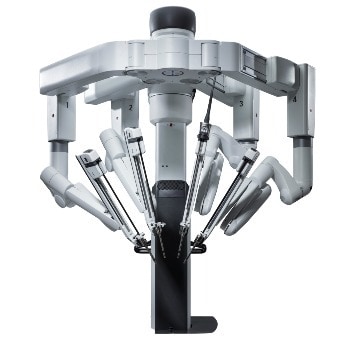Cancer Surgery
For many types of cancer, surgery offers the best and most immediate opportunity for a cure and full recovery. In addition to removing cancer, surgery can also help minimize adverse effects and preserve or restore function.
At Torrance Memorial’s Hunt Cancer Institute, an affiliate of Cedars-Sinai Cancer, our highly trained and skilled surgeons use leading technology in our state-of-the-art surgical department to provide optimal care.
Our surgeons have expertise in a wide variety of cancer surgeries, including:
- Breast surgery
- Reconstructive surgery
- Abdominal surgery for gynecologic malignancies
- Surgery of the digestive tract
- Prostate surgery
- Thoracic surgery, including VATS
- Surgery for cancer of urinary tract
- Neurosurgery
Minimally Invasive Surgery
Today many surgical procedures—including those for cancer—can be done utilizing sophisticated instruments. Laparoscopic surgery involves placing a fiber-optic tube equipped with a light and a small camera into the abdomen through one or more small incisions. A laparoscopic surgical procedure is performing using small agile instruments that are also passed through the tube.
While laparoscopic surgery is not appropriate for all patients or all surgical procedures, there are several advantages to be gained with this minimally invasive approach:
- Faster healing and recovery
- Less bleeding and a lower risk of complications
- Less post-surgical pain, because the incisions are smaller
The da Vinci Xi® Surgical System
 Also called the da Vinci robot, this advanced technology takes the least invasive approach available. With 3-D imaging, the ability to pivot at the site of small incisions, and microscopic, easy-to-manipulate instruments, the da Vinci Surgical System offers greater visualization and more precision than laparoscopic or open surgical techniques.
Also called the da Vinci robot, this advanced technology takes the least invasive approach available. With 3-D imaging, the ability to pivot at the site of small incisions, and microscopic, easy-to-manipulate instruments, the da Vinci Surgical System offers greater visualization and more precision than laparoscopic or open surgical techniques.
Surgeons who use the da Vinci Surgical System complete extensive training. Throughout your procedure, your surgeon remains in complete control of the system. It is not computer controlled or programmed.
Our da Vinci Surgical System enables surgeons to perform complex procedures to remove cancer without damaging the sensitive tissues surrounding the tumor or incision area. There is less bleeding, post-surgical pain and discomfort so healing and recovery are faster and easier. These advantages may be especially important for prostate and gynecological surgeries so, here at Torrance Memorial, our surgeons often use the da Vinci system to perform these procedures.
Endoscopic Surgery
What some call scarless surgery, some tumors of the gastrointestinal tract can be completely removed and treated through the mouth or rectum. Small or early cancers, particularly of the esophagus, stomach, colon and rectum can be safely removed and cured without scars and with minimal recovery time.
Video-Assisted Thoracic Surgery (VATS)
An advanced technology used in minimally-invasive lung surgery (and most particularly in early-stage lung cancer), video-assisted thoracic surgery (VATS) features enhanced magnification and small instruments to enable surgeons to perform lung procedures without opening the rib cage.
Patient benefits of VATS include:
- Less pain after the operation
- Better immune system response
- Better chance of breathing normally
- Better quality of life
The Whipple Procedure
The complex Whipple procedure (pancreaticoduodenoctomy), involving removal of a portion of the pancreas, bile duct, gallbladder, duodenum and stomach, requires a high level of skill, expertise and experience. For some patients with early stage pancreatic cancer that has not spread to other parts of the body, this procedure may offer a cure.
The goal of the Whipple procedure is full removal of the head of the pancreas and its surrounding organs, which include the curve of the duodenum, half of the stomach, the gall bladder, cystic duct, common bile duct and nearby lymph nodes. Reconstruction preserves digestive function and allow passage of digestive juices from the pancreas and bile from the liver into the digestive tract.

